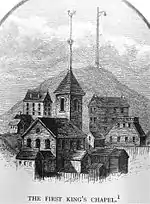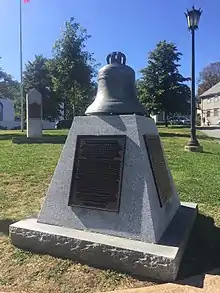St. John's Anglican Church (Lunenburg)
St. John's Anglican Church was the first church established in Lunenburg, Nova Scotia, Canada (1754). It is the second Church of England built in Nova Scotia, and is the second oldest remaining Protestant church in present-day Canada. Early on 1 November 2001, St. John's church suffered significant damage by fire. It was restored and re-dedicated June 12, 2005.

The congregation was mainly Lutheran Germans. The first missionary was sent by the Society for the Propagation of the Gospel was the Rev. Jean-Baptiste Moreau (clergyman) (who is buried in the crypt below the church).[1] Dettlieb Christopher Jessen donated a church bell that is displayed on the church grounds. (Jessen had the bell made by the Whitechapel Bell Foundry in London, the same company that made Big Ben and the Liberty Bell.) Jessen also donated the silver Chalice to the church (1814). Bells in the tower were given by Lt. Col. Charles Edwin Kaulbach (1902). Rev. Roger Aitken established the rectory for the church on Townsend Street (c.1824).[2]
The stone monument to John Creighton Sr. in the church was created by John Bacon (1777–1859), a nineteenth century sculptor. He created six monuments in St. Paul's Cathedral and many in Westminster Abbey.
The Church Building

St. John's Church was built during the French and Indian War, using the wood salvaged from an older disassembled church building. When King's Chapel in Boston, Massachusetts, was expanded, its new stone structure was built around its original wooden church, which continued to be used. Then, when that new stone building was completed in 1754, King's Chapel's old wooden frame was disassembled from inside, removed through the new building's windows, and shipped to Lunenburg.[3] Early on 1 November 2001, St. John's church suffered significant damage by fire. It was restored and re-dedicated June 12, 2005.[4] During reconstruction a mystery emerged concerning numerous stars painted within the Church, and which subsequently garnered the interest of international media and astronomers, as the remarkable star scene may convey the night-sky on the first Christmas (some 2 millennia ago) as seen from Lunenburg.[5][6]
In 2005, the church contributed wood from a salvaged pew to the Six String Nation project. Parts of that material serve multiple functions within Voyageur, the guitar at the heart of the project,[7] including a back brace, a reinforcing strip and kerfing, all on the interior of the instrument.
The Crypt

There are 18 people buried in the crypt. 7 people are under age 17. The notable interments include:
Founders of Lunenburg
- Dettlieb Christopher Jessen, (d. 1814), fought in the Raid on Lunenburg (1782), donated church bell and silver chalice; wife of Jessen, Francisca Barbara (Rudolf) Jessen (d. 1807)
- John Creighton Sr. (d. 1806), fought in the Raid on Lunenburg (1782)[8]
- Hon. Sebastian Zouberbuhler, (d.1773), fought in the Siege of Louisbourg (1745); became first of 3 Justice of the Peace in Lunenburg along with John Creighton and Patrick Sutherland.[9]
- Rev. Jean-Baptiste Moreau (clergyman) (d.1770), 1st minister[10]
Others
- Rev. Paulus Bryzelius (d. 1773), minister[11][12]
- Rev. Thomas Shreve (d. 1816), minister; soldier during the American Revolution
- John Creighton Jr. (d. 1826)
- Honorable Francis Joseph Rudolf (d. 1823)
- son of Rev. Peter de la Roche, William (age 1, d. 1776)[13]
- Miss Margaret Cheyne (1748-1821)
Ministers (1754-1852)

- Rev. Jean-Baptiste Moreau (1753-1770);
- Rev. Robert Vincent (clergyman) (1762-1765)
- Rev. Paulus Bryzelius (1768-1773)
- Rev. Peter de la Roche (1771-1787), signed ransom agreement with American privateers in the Raid on Lunenburg (1782) and became first Anglican minister at Guysborough, Nova Scotia.[14][15]
- Rev. Richard Money (1787-1803)[16]
- Rev. Thomas Shreve (1804-1816)
- Rev. Roger Aitken (1817-1825)[17][18][19][20]
- Rev. James Cuppaidge Cochran (1825-1852), who supported the establishment of the Halifax School for the Deaf[21][22]
Gallery

 Plaque to John Creighton Jr. and his son John Creighton
Plaque to John Creighton Jr. and his son John Creighton Governor Michael Francklin's Bible (1765); originally owned by Rev. Robert Vincent, second minister of St. John's (.c. 1761)
Governor Michael Francklin's Bible (1765); originally owned by Rev. Robert Vincent, second minister of St. John's (.c. 1761)

 Francis Rudolf, The Crypt
Francis Rudolf, The Crypt Rev. Thomas Shreve
Rev. Thomas Shreve Rectory, St. John's Anglican Church, Lunenburg, Nova Scotia (c 1824)
Rectory, St. John's Anglican Church, Lunenburg, Nova Scotia (c 1824)
See also
References
| Wikimedia Commons has media related to St. John's Anglican Church (Lunenburg). |
- http://www.rootsweb.ancestry.com/~nslssgs/sjhist.htm
- HistoricPlaces.Ca. Note: HistoricPlaces.ca asserts erroneously that the rectory was finished by 1816, before Aitkins arrived.
- "King's Chapel". Freedom Trail Foundation. 2013. Archived from the original on 2013-03-25. Retrieved 24 February 2013.
- O'Connor, John (December 23, 2014). "Holy jigsaw puzzle: After a fire gutted a historic church, N.S. town began an incredible reconstruction". National Post. Retrieved 24 February 2017.
- "Ancient Stars Shine On". Astronomy Magazine. 2004.
- "The Mysterious Stars of St. John's Church Lunenburg". Discovery Channel. 2004.
- Jowi., Taylor (2009). Six string nation : 64 pieces, 6 strings, 1 Canada, 1 guitar. Vancouver: Douglas & McIntyre. ISBN 9781553653936. OCLC 302060380.
- http://www.lunenburgheritagesociety.ca/images/June2005%20.pdf
- p. 31
- p. 81
- p. 83
- Acadie and the Acadians By D. Luther Roth, pp.270-281
- p. 84
- Grave in Guysborough
- http://guyscogene.net/cem/christchurchguys.html
- p. 85
- History of the County of Lunenburg By Mather Byles DesBrisay, p. 86
- Main correspondents: Rev. Roger Aitken, Aberdeen/Lunenburg, 1814-25
- p. 212
- 'AITKEN, ROGER, ?-1825' A house is not a home - Rev. Roger Aitken and the struggle for a Lunenburg rectory. By Allan C. Dunlop. In Collections of the Nova Scotia Historical Society. Vol 41, pp. 47-63.
- Canadian Biography
- https://archive.org/stream/cihm_13059#page/n3/mode/2up